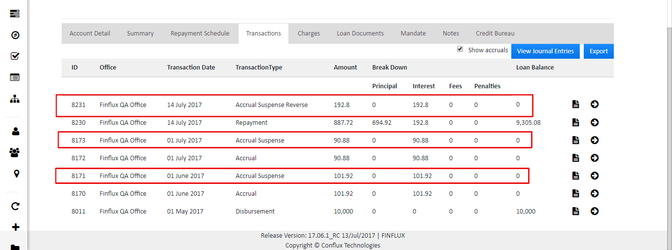NPA Suspense account mapping
Step 1: Navigate to Accounting>>Chart of Account>>Add Account. Add NPA suspense Accounts (Liability Accounts). Refer Chart of Account.
Step 2: Create Loan Product and define the loan product. Add NPA suspense accounts for Interest, Fees and Penalties as shown in the fig 1 below.
Fig 1: Loan Product
Step 3: Apply for a loan, approve and disburse the loan.Refer Loan Account Application
Step 4: Navigate to Admin>>System>>Scheduler Job and run the accrual and their dependent jobs
Step 5: Click on the transaction tab and tick mark "select accruals". This will show the accrual transaction and their respective NPA accrual transaction. as shown in the fig
| # | Transaction Type | Description |
|---|---|---|
| 1. | Accrual Suspense | Once the status moves to NPA state then the accruals will me credited into the Accrual suspense account |
| 2. | Accrual Suspense Reverse | If the accruals are repaid then the accrual suspense transaction will be reveresed i.e., Accrual Suspense account will get debited. |
Example: Bob applies for a loan amount of 10000 on 1 May 2017 and say for an instance he will miss two repayments that is on 1 June 2017 and 1st July 2017 and will make the repayment on 14 July 2017. This account will move to the NPA state since he had not repaid the installments from 60 day (days for NPA defined in Loan Product). Hence the accrued interest will be credited into the interest suspense account as defined in the loan product. Once the repayment is done then the reversal of Accrual suspense transaction is done. Refer NPA Accounting for more info
Note: Similarly accrued fees and penalties get credited into the respective suspense account when accrual suspense transaction is done and gets debited once reversal of accrual suspense transaction is done.
Fig 2: Transactions
Step 6: View Journal Entries for Accrual Suspense and Accrual Suspense Reverse.
Fig 3 and Fig 4 shows the Journal entry when Accrual suspense transaction is done and fig 5 shows the Journal entry for Accrual suspense reverse transaction.
Fig 3: Journal Entries for Accrual suspense transaction
Fig 4: Journal Entries for Accrual suspense transaction
Fig 5: Journal Entries for Accrual suspense reverse transaction




